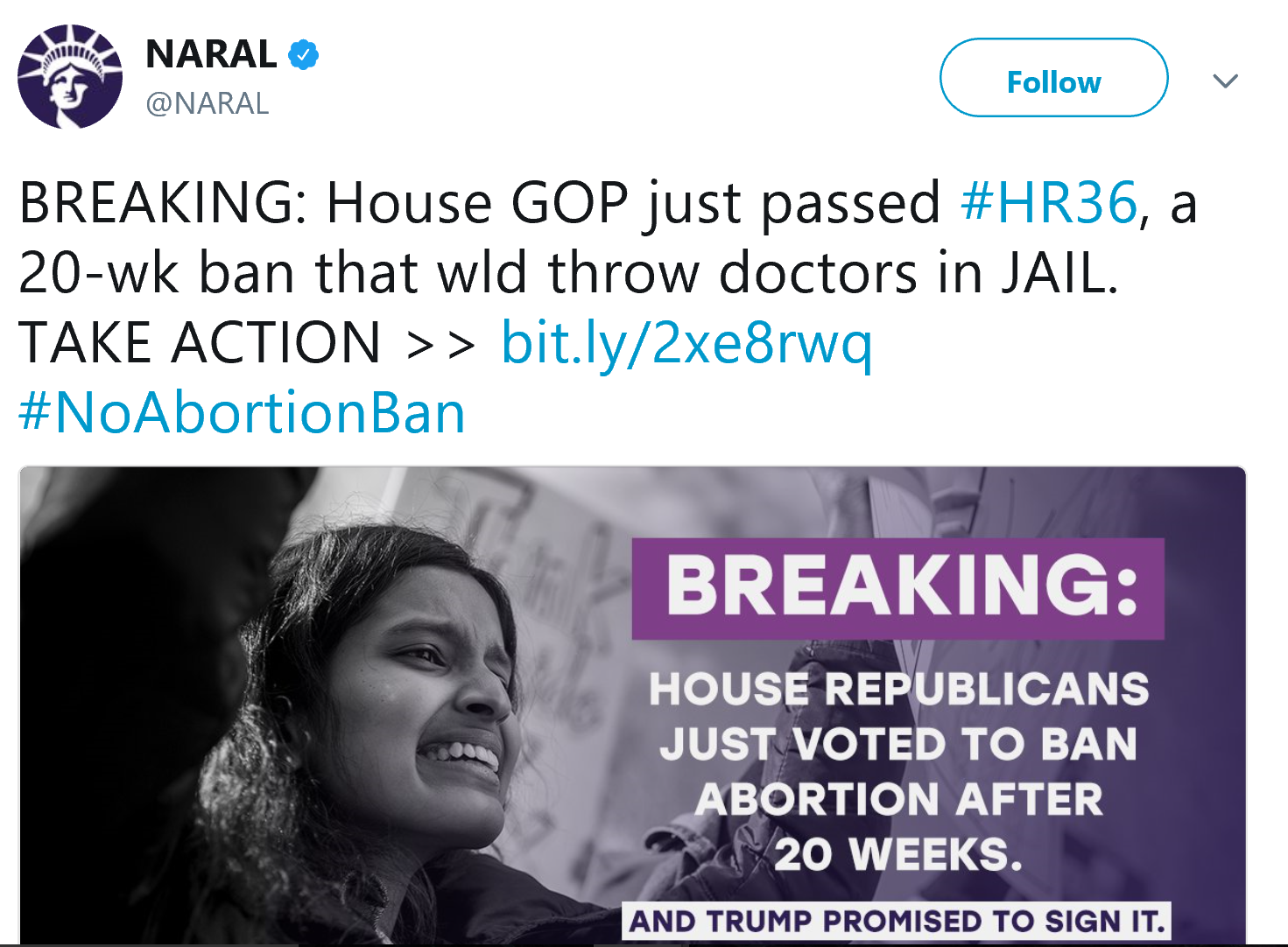
There’s some fake news going around, and fake science too boot. With the House’s passage of the Pain-Capable Unborn Child Protection Act last week, and Sen. Lindsey Graham’s announcement that he will reintroduce similar legislation in the Senate, abortion activists are warning of the dire threat to “reproductive health” a 20-week ban on abortion presents.
Planned Parenthood’s talking points say “20-week bans are part of an agenda to ban all abortion. Anti-abortion politicians in congress and in state legislatures are pushing their agenda, bit by bit, to ultimately outlaw abortion completely.” NARAL jumped in on Twitter:

And here’s digital media giant Refinery29: “The Pain-Capable Unborn Child Protection Act bans abortion procedures after 20 weeks of gestation, except in cases of rape, incest, or danger to the mother’s life.”
The ban, though, is not a ban of abortions at 20 weeks of pregnancy or a gestational age of 20 weeks, but of abortions at 22 weeks of pregnancy. Here’s why.
Doctors Start the Clock Two Weeks Early
A woman’s reproductive cycle lasts, on average, 28 days. Day 1 is the first day of menstruation. A healthy woman not absorbing hormonal birth control will ovulate about two weeks later and, if fertilization occurs, it will occur within 24 hours of ovulation. If a woman does not conceive, her menstrual cycle will begin approximately two weeks after ovulation, or 28 days after she began her period.
However, because many women do not know the date on which they ovulated (and cannot know the exact moment of fertilization), after a woman misses her period and tests positive on a pregnancy test, her doctor will date her pregnancy based on the first day of her last period. Thus, when a doctor tells a woman she is four weeks pregnant, that typically means that she started her last period four weeks ago. The unborn baby, though, will only be two weeks old at that point. The baby will be a slightly different age also for mothers whose cycles are longer or shorter than 28 days, which is why this pregnancy dating method is merely a triangulation based on averages.
Gestational age similarly refers not to the actual age of the fetus, but to the number of weeks since a woman’s last menstrual period, or LMP. Planned Parenthood provides this sidebar definition:

The Bill’s Language Reflects The Scientific Reality
The convention of dating pregnancies by LMP is so ingrained in our culture that everyone seems to assume that when Congress speaks of a 20-week ban on abortions, they mean 20 weeks as used in the vernacular. But that is not what the statute says. Here’s the statutory language:
- GENERALLY FOR UNBORN CHILDREN 20 WEEKS OR OLDER.—Except as provided in subparagraph (B), the abortion shall not be performed or attempted, if the probable post-fertilization age, as determined under paragraph (1), of the unborn child is 20 weeks or greater.
There is a reason Congress used the 20-week post-fertilization measure: the science underlying the ban is based on the actual developmental age of the unborn baby and not the estimate physicians use based on the LMP. The developmental age of the fetus can be determined more accurately from ultrasounds, but that is usually unnecessary and always more expensive than merely estimating the due date based on the LMP.
From the congressional findings:
Pain receptors (nociceptors) are present throughout the unborn child’s entire body and nerves link these receptors to the brain’s thalamus and subcortical plate by no later than 20 weeks after fertilization. [i.e., 22 weeks old in the vernacular]
For the purposes of surgery on unborn children, fetal anesthesia is routinely administered and is associated with a decrease in stress hormones compared to their level when painful stimuli are applied without such anesthesia. In the United States, surgery of this type is being performed by 20 weeks after fertilization and earlier in specialized units affiliated with children’s hospitals.
Given that the statutory language bans abortions at 20 weeks post-fertilization, but that doctors and laypeople alike speak of pregnancy in weeks based on the last menstrual period—which occurs two weeks earlier—proper reporting of the proposed law would explain that Congress seeks to ban abortions after 22 weeks of pregnancy.
Yet nearly every news outlet uses the scientifically and legislatively inaccurate language of a 20-week ban in favor of the colloquial and less-precise 20-week language. Politico, for instance, reported: “Sen. Lindsey Graham (R-S.C.) on Thursday will reintroduce his bill to ban abortions nationwide after 20 weeks of pregnancy, which failed on the Senate floor two years ago, 54-42.” This headline topped the Washington Post webpage.

Here is one from CNN.

Of course, even precise reporting won’t make a difference to the abortion-is-fine-until-you-bring-your-baby-home-from-the-hospital crowd. But for most Americans, killing an unborn baby at 20 weeks is repulsive. Killing him at 22 weeks is incomprehensibly barbaric.
After all, the public is well-acquainted with the stories of survival of the tiniest premature babies, like Amillia Taylor, who was born exactly 21 weeks and 6 days post-fertilization. As medical advances continue, such as the development of an “artificial womb,” more and younger preterm babies will survive. That is, if they escape the womb unscathed. The Pain-Capable Unborn Child Protection Act hopes to make that possible.










